Impact of Gender on Workplace Discrimination in the US Construction Industry
VerifiedAdded on 2023/05/30
|21
|3877
|459
AI Summary
This study explores the impact of gender on workplace discrimination in the US construction industry. It discusses the challenges faced by women, including wage differences and motivation issues. The study uses both descriptive and correlational design, and data was collected through questionnaires. Results show that women workers in the construction industry are poorly remunerated compared to their male counterparts. The study recommends measures to ensure gender equality in the industry.
Contribute Materials
Your contribution can guide someone’s learning journey. Share your
documents today.
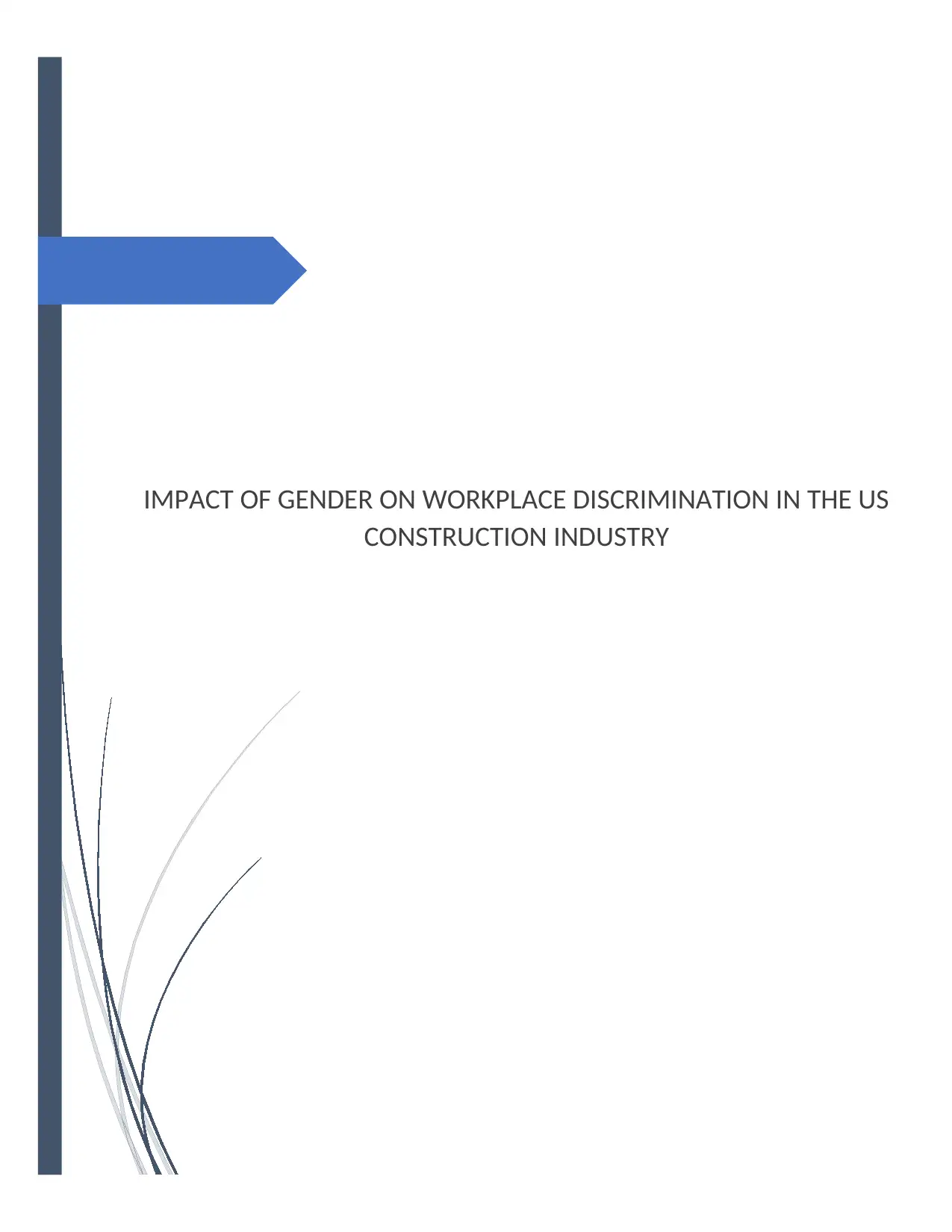
IMPACT OF GENDER ON WORKPLACE DISCRIMINATION IN THE US
CONSTRUCTION INDUSTRY
CONSTRUCTION INDUSTRY
Secure Best Marks with AI Grader
Need help grading? Try our AI Grader for instant feedback on your assignments.

Table of Contents
Introduction.................................................................................................................................................1
Problem statement..................................................................................................................................1
Literature review.........................................................................................................................................2
Women construction employees.............................................................................................................2
Challenges faced by women in the construction industry.......................................................................3
Research questions and objectives..........................................................................................................4
Hypotheses..............................................................................................................................................5
Research Methodology................................................................................................................................6
Study design............................................................................................................................................6
Data collection.........................................................................................................................................6
Data analysis............................................................................................................................................6
Results.........................................................................................................................................................7
Descriptive statistics................................................................................................................................7
Wages..................................................................................................................................................7
Motivation...........................................................................................................................................8
Cross tabulation.......................................................................................................................................9
Inferential statistics...............................................................................................................................11
Correlation analysis...........................................................................................................................11
Discussion..................................................................................................................................................12
Conclusion, Limitations and Recommendations........................................................................................13
Conclusion.............................................................................................................................................13
Limitations.............................................................................................................................................14
Recommendations.................................................................................................................................14
References.................................................................................................................................................15
Appendix...................................................................................................................................................17
1
Introduction.................................................................................................................................................1
Problem statement..................................................................................................................................1
Literature review.........................................................................................................................................2
Women construction employees.............................................................................................................2
Challenges faced by women in the construction industry.......................................................................3
Research questions and objectives..........................................................................................................4
Hypotheses..............................................................................................................................................5
Research Methodology................................................................................................................................6
Study design............................................................................................................................................6
Data collection.........................................................................................................................................6
Data analysis............................................................................................................................................6
Results.........................................................................................................................................................7
Descriptive statistics................................................................................................................................7
Wages..................................................................................................................................................7
Motivation...........................................................................................................................................8
Cross tabulation.......................................................................................................................................9
Inferential statistics...............................................................................................................................11
Correlation analysis...........................................................................................................................11
Discussion..................................................................................................................................................12
Conclusion, Limitations and Recommendations........................................................................................13
Conclusion.............................................................................................................................................13
Limitations.............................................................................................................................................14
Recommendations.................................................................................................................................14
References.................................................................................................................................................15
Appendix...................................................................................................................................................17
1
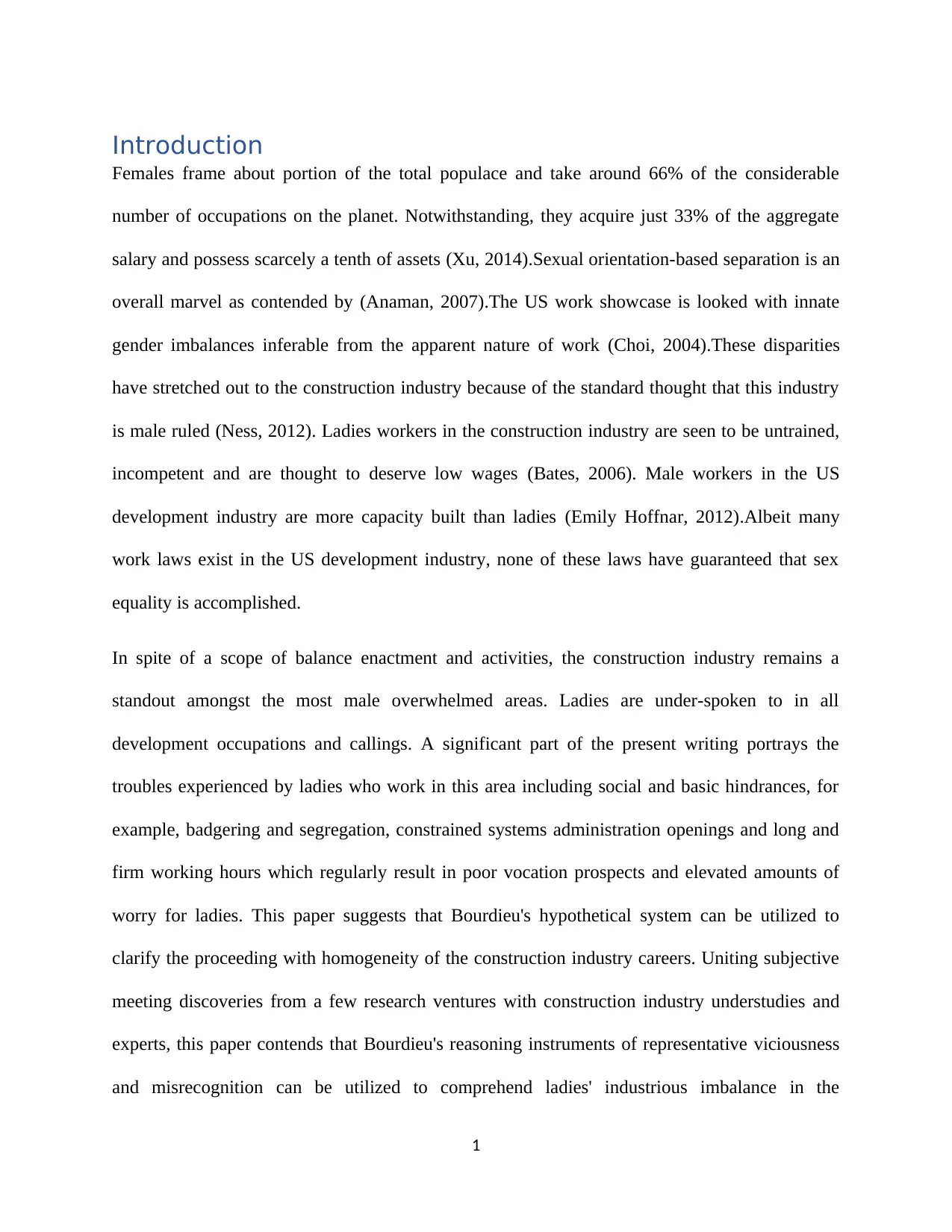
Introduction
Females frame about portion of the total populace and take around 66% of the considerable
number of occupations on the planet. Notwithstanding, they acquire just 33% of the aggregate
salary and possess scarcely a tenth of assets (Xu, 2014).Sexual orientation-based separation is an
overall marvel as contended by (Anaman, 2007).The US work showcase is looked with innate
gender imbalances inferable from the apparent nature of work (Choi, 2004).These disparities
have stretched out to the construction industry because of the standard thought that this industry
is male ruled (Ness, 2012). Ladies workers in the construction industry are seen to be untrained,
incompetent and are thought to deserve low wages (Bates, 2006). Male workers in the US
development industry are more capacity built than ladies (Emily Hoffnar, 2012).Albeit many
work laws exist in the US development industry, none of these laws have guaranteed that sex
equality is accomplished.
In spite of a scope of balance enactment and activities, the construction industry remains a
standout amongst the most male overwhelmed areas. Ladies are under-spoken to in all
development occupations and callings. A significant part of the present writing portrays the
troubles experienced by ladies who work in this area including social and basic hindrances, for
example, badgering and segregation, constrained systems administration openings and long and
firm working hours which regularly result in poor vocation prospects and elevated amounts of
worry for ladies. This paper suggests that Bourdieu's hypothetical system can be utilized to
clarify the proceeding with homogeneity of the construction industry careers. Uniting subjective
meeting discoveries from a few research ventures with construction industry understudies and
experts, this paper contends that Bourdieu's reasoning instruments of representative viciousness
and misrecognition can be utilized to comprehend ladies' industrious imbalance in the
1
Females frame about portion of the total populace and take around 66% of the considerable
number of occupations on the planet. Notwithstanding, they acquire just 33% of the aggregate
salary and possess scarcely a tenth of assets (Xu, 2014).Sexual orientation-based separation is an
overall marvel as contended by (Anaman, 2007).The US work showcase is looked with innate
gender imbalances inferable from the apparent nature of work (Choi, 2004).These disparities
have stretched out to the construction industry because of the standard thought that this industry
is male ruled (Ness, 2012). Ladies workers in the construction industry are seen to be untrained,
incompetent and are thought to deserve low wages (Bates, 2006). Male workers in the US
development industry are more capacity built than ladies (Emily Hoffnar, 2012).Albeit many
work laws exist in the US development industry, none of these laws have guaranteed that sex
equality is accomplished.
In spite of a scope of balance enactment and activities, the construction industry remains a
standout amongst the most male overwhelmed areas. Ladies are under-spoken to in all
development occupations and callings. A significant part of the present writing portrays the
troubles experienced by ladies who work in this area including social and basic hindrances, for
example, badgering and segregation, constrained systems administration openings and long and
firm working hours which regularly result in poor vocation prospects and elevated amounts of
worry for ladies. This paper suggests that Bourdieu's hypothetical system can be utilized to
clarify the proceeding with homogeneity of the construction industry careers. Uniting subjective
meeting discoveries from a few research ventures with construction industry understudies and
experts, this paper contends that Bourdieu's reasoning instruments of representative viciousness
and misrecognition can be utilized to comprehend ladies' industrious imbalance in the
1
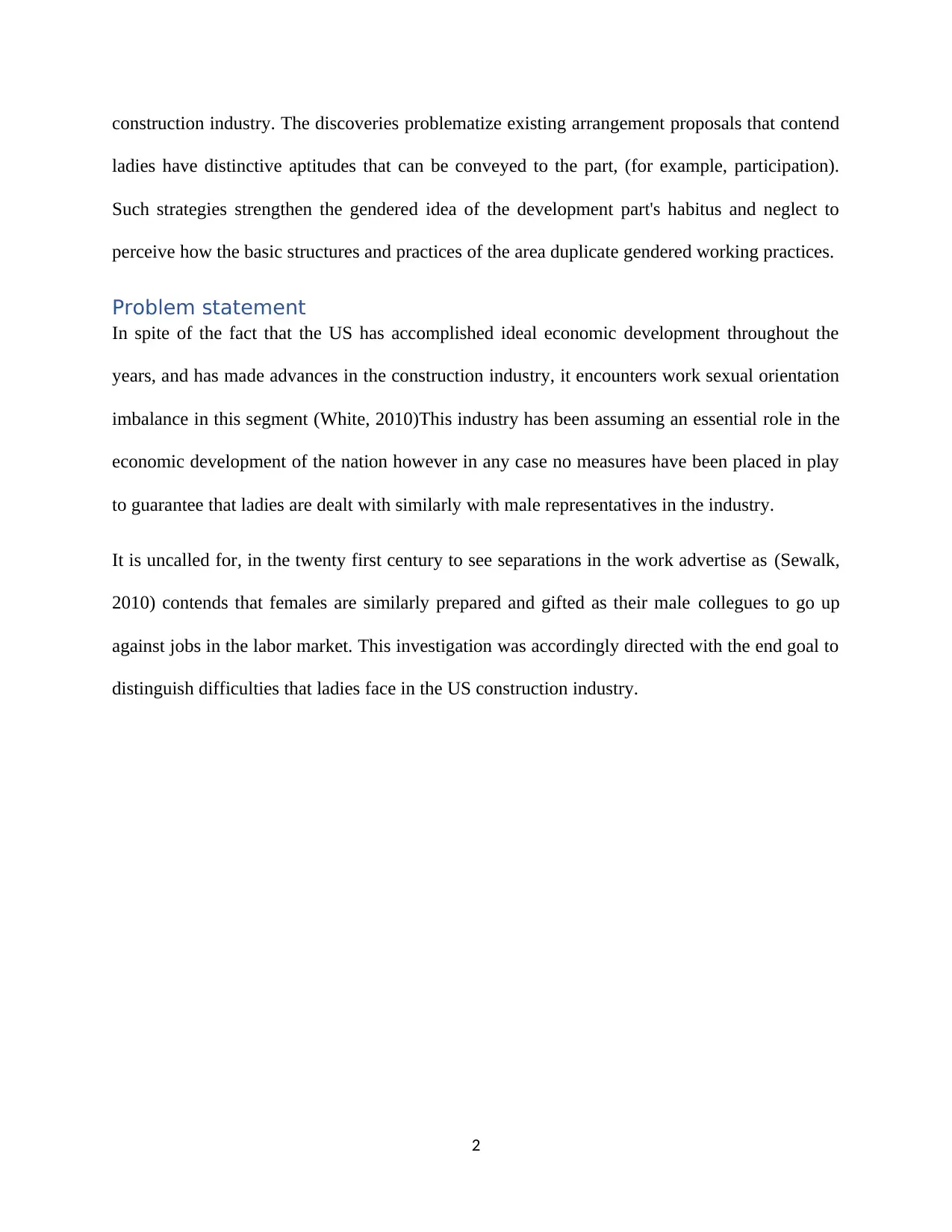
construction industry. The discoveries problematize existing arrangement proposals that contend
ladies have distinctive aptitudes that can be conveyed to the part, (for example, participation).
Such strategies strengthen the gendered idea of the development part's habitus and neglect to
perceive how the basic structures and practices of the area duplicate gendered working practices.
Problem statement
In spite of the fact that the US has accomplished ideal economic development throughout the
years, and has made advances in the construction industry, it encounters work sexual orientation
imbalance in this segment (White, 2010)This industry has been assuming an essential role in the
economic development of the nation however in any case no measures have been placed in play
to guarantee that ladies are dealt with similarly with male representatives in the industry.
It is uncalled for, in the twenty first century to see separations in the work advertise as (Sewalk,
2010) contends that females are similarly prepared and gifted as their male collegues to go up
against jobs in the labor market. This investigation was accordingly directed with the end goal to
distinguish difficulties that ladies face in the US construction industry.
2
ladies have distinctive aptitudes that can be conveyed to the part, (for example, participation).
Such strategies strengthen the gendered idea of the development part's habitus and neglect to
perceive how the basic structures and practices of the area duplicate gendered working practices.
Problem statement
In spite of the fact that the US has accomplished ideal economic development throughout the
years, and has made advances in the construction industry, it encounters work sexual orientation
imbalance in this segment (White, 2010)This industry has been assuming an essential role in the
economic development of the nation however in any case no measures have been placed in play
to guarantee that ladies are dealt with similarly with male representatives in the industry.
It is uncalled for, in the twenty first century to see separations in the work advertise as (Sewalk,
2010) contends that females are similarly prepared and gifted as their male collegues to go up
against jobs in the labor market. This investigation was accordingly directed with the end goal to
distinguish difficulties that ladies face in the US construction industry.
2
Secure Best Marks with AI Grader
Need help grading? Try our AI Grader for instant feedback on your assignments.

Literature review
Women construction employees
As per (GURA N., 2010) ladies in the development business are supplanted in the accompanying
three dimensions;
Technical positions, for example, planners and architects. About 1.2 % of ladies in the
US function as construction technical officers.
Administrative positions, for example, managers.
Construction laborers.
All inclusive, under 10% of construction laborers constitute ladies (Contemporary, 2013).Be that
as it may, relentless increment of ladies who enter the construction has been seen over the
previous decade. Demand for construction specialists has similarly gone high. Ladies
accordingly think that its now less demanding to discover employments in the construction
industry (Gad, 2014).This situation is seen in the US construction industry.
In the twenty first century, fairness is a standard that ought to be seen in each area of economy.
The US construction industry ought to expedite more ladies aboard with the rising interest for
construction laborers (Committee on Advancing the Competitiveness and Productivity of the
U.S. Construction Industry, Advancing the Competitiveness and Efficiency of the U.S.
Construction Industry, 2009)as more ladies are preparing for occupations in the development
industry.
(Frank Carr, 2009) has demonstrated that the numbers among male and female in classrooms
preparing for occupations in the construction industry is starting to measure up.
However, there is constrained data on ladies workers' welfare in the US construction industry.
3
Women construction employees
As per (GURA N., 2010) ladies in the development business are supplanted in the accompanying
three dimensions;
Technical positions, for example, planners and architects. About 1.2 % of ladies in the
US function as construction technical officers.
Administrative positions, for example, managers.
Construction laborers.
All inclusive, under 10% of construction laborers constitute ladies (Contemporary, 2013).Be that
as it may, relentless increment of ladies who enter the construction has been seen over the
previous decade. Demand for construction specialists has similarly gone high. Ladies
accordingly think that its now less demanding to discover employments in the construction
industry (Gad, 2014).This situation is seen in the US construction industry.
In the twenty first century, fairness is a standard that ought to be seen in each area of economy.
The US construction industry ought to expedite more ladies aboard with the rising interest for
construction laborers (Committee on Advancing the Competitiveness and Productivity of the
U.S. Construction Industry, Advancing the Competitiveness and Efficiency of the U.S.
Construction Industry, 2009)as more ladies are preparing for occupations in the development
industry.
(Frank Carr, 2009) has demonstrated that the numbers among male and female in classrooms
preparing for occupations in the construction industry is starting to measure up.
However, there is constrained data on ladies workers' welfare in the US construction industry.
3

Challenges faced by women in the construction industry
In the US, different investigations have demonstrated that ladies face heaps of difficulties in the
construction industry (Administration, 2008). As indicated by the Occupational Safety and
Health organization inquire about done in 1999, it was demonstrated that 88 % ladies in the US
construction industry face sexual harassment.
Other than lewd behavior, there exist different difficulties that ladies face in the US construction
industry as illustrated by (Coombes Davies, 2009). Segregation on essential pleasantries, for
example, washrooms is one such test.
Another research conducted by ladies development specialists in the Indian development
industry is imbalance concerning renumeration contrasted with their male colleague workers
(Bridges, 2009). Females development specialists were discovered to be paid substantially less
contrasted with male development laborers (Pamulu, 2014).
In addition, as indicated by (Abdel-Mohsen Onsy Mohamed, 2011)lesser ladies contrasted with
men have ascended the positions to go up against administrative positions in the Indian
development industry. Men command top positions while ladies possess junior positions. Ladies
are not surveyed by their aptitudes, but rather by orientation of their gender (Committee on
Advancing the Competitiveness and Productivity of the U.S. Construction Industry, Advancing
the Competitiveness and Efficiency of the U.S. Construction Industry, 2009) and therefore along
these lines separated.
As discovered by (Group, 2009)it has likewise been demonstrated that ladies workers in the US
development industry are not equally motivated as men. Research has demonstrated that
extraneous motivation affects worker execution. Females are ineffectively treated to this kind of
inspiration, hence bringing down their work yield. Men will in general be spurred better
4
In the US, different investigations have demonstrated that ladies face heaps of difficulties in the
construction industry (Administration, 2008). As indicated by the Occupational Safety and
Health organization inquire about done in 1999, it was demonstrated that 88 % ladies in the US
construction industry face sexual harassment.
Other than lewd behavior, there exist different difficulties that ladies face in the US construction
industry as illustrated by (Coombes Davies, 2009). Segregation on essential pleasantries, for
example, washrooms is one such test.
Another research conducted by ladies development specialists in the Indian development
industry is imbalance concerning renumeration contrasted with their male colleague workers
(Bridges, 2009). Females development specialists were discovered to be paid substantially less
contrasted with male development laborers (Pamulu, 2014).
In addition, as indicated by (Abdel-Mohsen Onsy Mohamed, 2011)lesser ladies contrasted with
men have ascended the positions to go up against administrative positions in the Indian
development industry. Men command top positions while ladies possess junior positions. Ladies
are not surveyed by their aptitudes, but rather by orientation of their gender (Committee on
Advancing the Competitiveness and Productivity of the U.S. Construction Industry, Advancing
the Competitiveness and Efficiency of the U.S. Construction Industry, 2009) and therefore along
these lines separated.
As discovered by (Group, 2009)it has likewise been demonstrated that ladies workers in the US
development industry are not equally motivated as men. Research has demonstrated that
extraneous motivation affects worker execution. Females are ineffectively treated to this kind of
inspiration, hence bringing down their work yield. Men will in general be spurred better
4
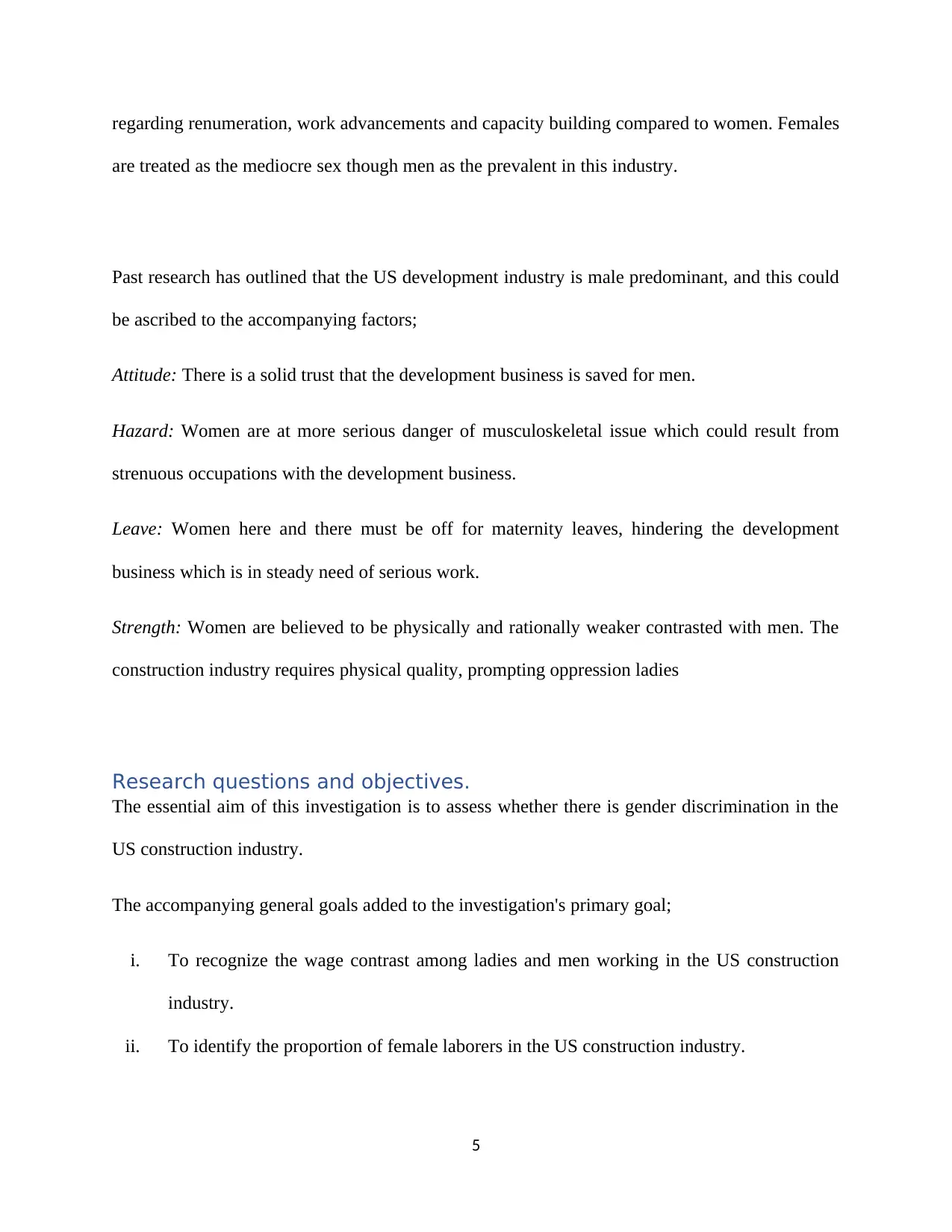
regarding renumeration, work advancements and capacity building compared to women. Females
are treated as the mediocre sex though men as the prevalent in this industry.
Past research has outlined that the US development industry is male predominant, and this could
be ascribed to the accompanying factors;
Attitude: There is a solid trust that the development business is saved for men.
Hazard: Women are at more serious danger of musculoskeletal issue which could result from
strenuous occupations with the development business.
Leave: Women here and there must be off for maternity leaves, hindering the development
business which is in steady need of serious work.
Strength: Women are believed to be physically and rationally weaker contrasted with men. The
construction industry requires physical quality, prompting oppression ladies
Research questions and objectives.
The essential aim of this investigation is to assess whether there is gender discrimination in the
US construction industry.
The accompanying general goals added to the investigation's primary goal;
i. To recognize the wage contrast among ladies and men working in the US construction
industry.
ii. To identify the proportion of female laborers in the US construction industry.
5
are treated as the mediocre sex though men as the prevalent in this industry.
Past research has outlined that the US development industry is male predominant, and this could
be ascribed to the accompanying factors;
Attitude: There is a solid trust that the development business is saved for men.
Hazard: Women are at more serious danger of musculoskeletal issue which could result from
strenuous occupations with the development business.
Leave: Women here and there must be off for maternity leaves, hindering the development
business which is in steady need of serious work.
Strength: Women are believed to be physically and rationally weaker contrasted with men. The
construction industry requires physical quality, prompting oppression ladies
Research questions and objectives.
The essential aim of this investigation is to assess whether there is gender discrimination in the
US construction industry.
The accompanying general goals added to the investigation's primary goal;
i. To recognize the wage contrast among ladies and men working in the US construction
industry.
ii. To identify the proportion of female laborers in the US construction industry.
5
Paraphrase This Document
Need a fresh take? Get an instant paraphrase of this document with our AI Paraphraser
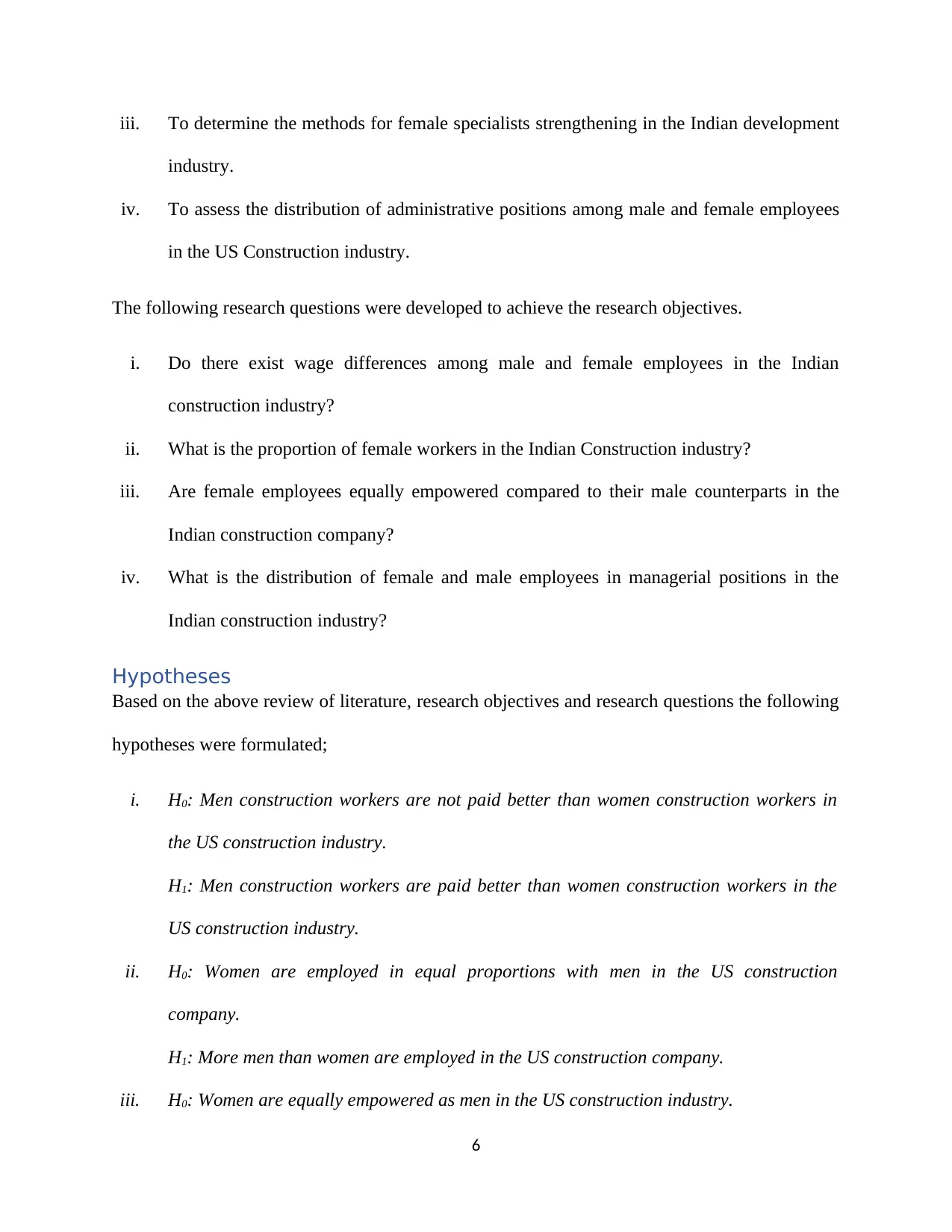
iii. To determine the methods for female specialists strengthening in the Indian development
industry.
iv. To assess the distribution of administrative positions among male and female employees
in the US Construction industry.
The following research questions were developed to achieve the research objectives.
i. Do there exist wage differences among male and female employees in the Indian
construction industry?
ii. What is the proportion of female workers in the Indian Construction industry?
iii. Are female employees equally empowered compared to their male counterparts in the
Indian construction company?
iv. What is the distribution of female and male employees in managerial positions in the
Indian construction industry?
Hypotheses
Based on the above review of literature, research objectives and research questions the following
hypotheses were formulated;
i. H0: Men construction workers are not paid better than women construction workers in
the US construction industry.
H1: Men construction workers are paid better than women construction workers in the
US construction industry.
ii. H0: Women are employed in equal proportions with men in the US construction
company.
H1: More men than women are employed in the US construction company.
iii. H0: Women are equally empowered as men in the US construction industry.
6
industry.
iv. To assess the distribution of administrative positions among male and female employees
in the US Construction industry.
The following research questions were developed to achieve the research objectives.
i. Do there exist wage differences among male and female employees in the Indian
construction industry?
ii. What is the proportion of female workers in the Indian Construction industry?
iii. Are female employees equally empowered compared to their male counterparts in the
Indian construction company?
iv. What is the distribution of female and male employees in managerial positions in the
Indian construction industry?
Hypotheses
Based on the above review of literature, research objectives and research questions the following
hypotheses were formulated;
i. H0: Men construction workers are not paid better than women construction workers in
the US construction industry.
H1: Men construction workers are paid better than women construction workers in the
US construction industry.
ii. H0: Women are employed in equal proportions with men in the US construction
company.
H1: More men than women are employed in the US construction company.
iii. H0: Women are equally empowered as men in the US construction industry.
6
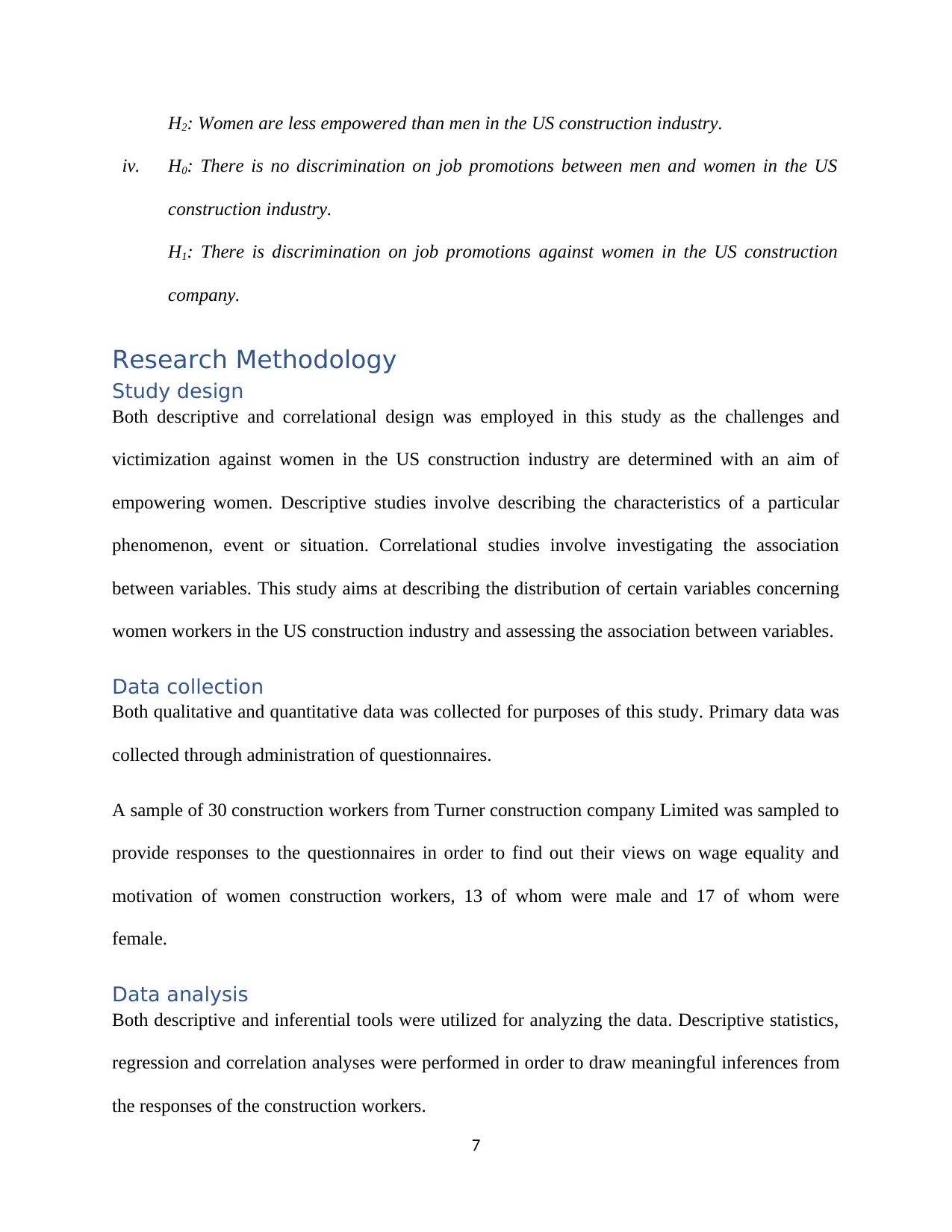
H2: Women are less empowered than men in the US construction industry.
iv. H0: There is no discrimination on job promotions between men and women in the US
construction industry.
H1: There is discrimination on job promotions against women in the US construction
company.
Research Methodology
Study design
Both descriptive and correlational design was employed in this study as the challenges and
victimization against women in the US construction industry are determined with an aim of
empowering women. Descriptive studies involve describing the characteristics of a particular
phenomenon, event or situation. Correlational studies involve investigating the association
between variables. This study aims at describing the distribution of certain variables concerning
women workers in the US construction industry and assessing the association between variables.
Data collection
Both qualitative and quantitative data was collected for purposes of this study. Primary data was
collected through administration of questionnaires.
A sample of 30 construction workers from Turner construction company Limited was sampled to
provide responses to the questionnaires in order to find out their views on wage equality and
motivation of women construction workers, 13 of whom were male and 17 of whom were
female.
Data analysis
Both descriptive and inferential tools were utilized for analyzing the data. Descriptive statistics,
regression and correlation analyses were performed in order to draw meaningful inferences from
the responses of the construction workers.
7
iv. H0: There is no discrimination on job promotions between men and women in the US
construction industry.
H1: There is discrimination on job promotions against women in the US construction
company.
Research Methodology
Study design
Both descriptive and correlational design was employed in this study as the challenges and
victimization against women in the US construction industry are determined with an aim of
empowering women. Descriptive studies involve describing the characteristics of a particular
phenomenon, event or situation. Correlational studies involve investigating the association
between variables. This study aims at describing the distribution of certain variables concerning
women workers in the US construction industry and assessing the association between variables.
Data collection
Both qualitative and quantitative data was collected for purposes of this study. Primary data was
collected through administration of questionnaires.
A sample of 30 construction workers from Turner construction company Limited was sampled to
provide responses to the questionnaires in order to find out their views on wage equality and
motivation of women construction workers, 13 of whom were male and 17 of whom were
female.
Data analysis
Both descriptive and inferential tools were utilized for analyzing the data. Descriptive statistics,
regression and correlation analyses were performed in order to draw meaningful inferences from
the responses of the construction workers.
7
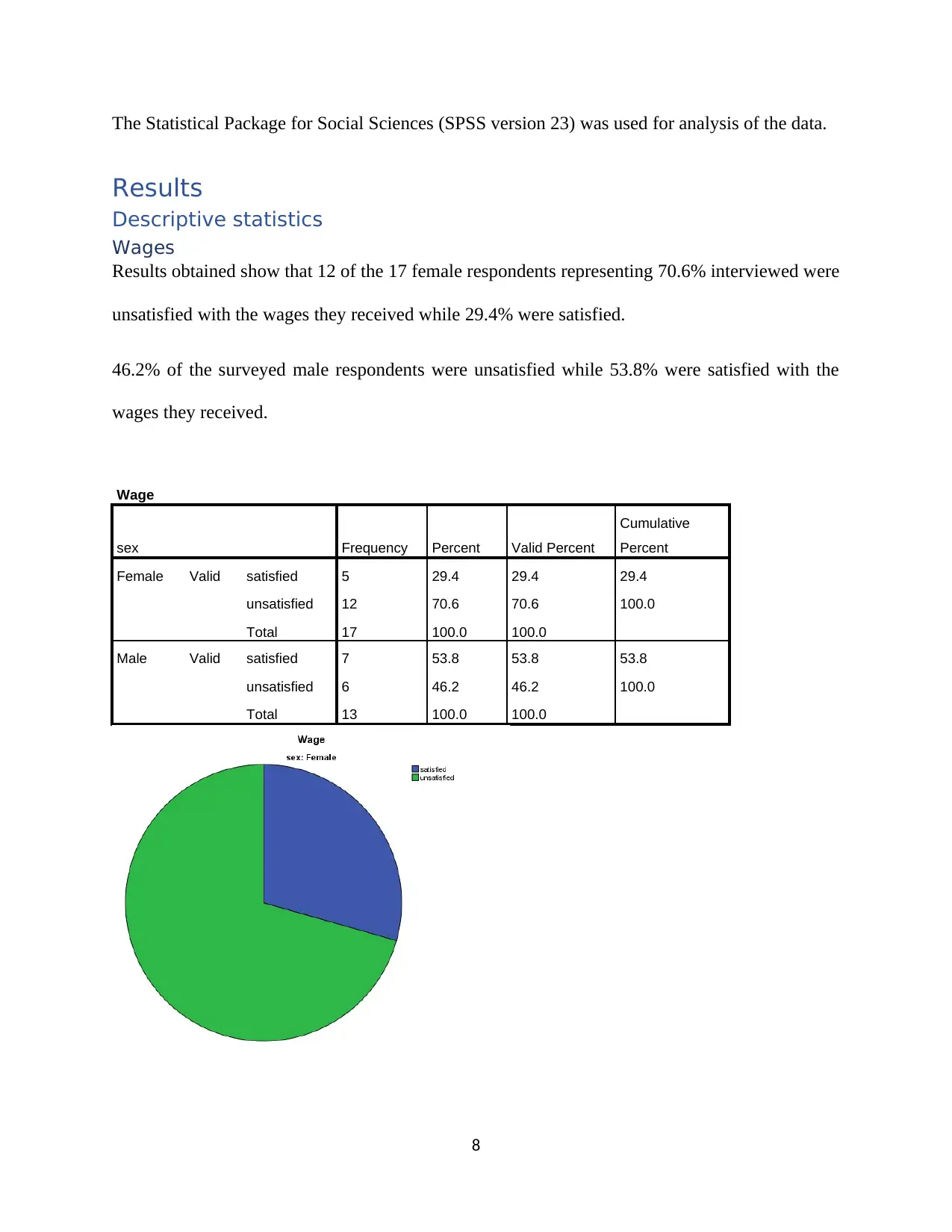
The Statistical Package for Social Sciences (SPSS version 23) was used for analysis of the data.
Results
Descriptive statistics
Wages
Results obtained show that 12 of the 17 female respondents representing 70.6% interviewed were
unsatisfied with the wages they received while 29.4% were satisfied.
46.2% of the surveyed male respondents were unsatisfied while 53.8% were satisfied with the
wages they received.
Wage
sex Frequency Percent Valid Percent
Cumulative
Percent
Female Valid satisfied 5 29.4 29.4 29.4
unsatisfied 12 70.6 70.6 100.0
Total 17 100.0 100.0
Male Valid satisfied 7 53.8 53.8 53.8
unsatisfied 6 46.2 46.2 100.0
Total 13 100.0 100.0
8
Results
Descriptive statistics
Wages
Results obtained show that 12 of the 17 female respondents representing 70.6% interviewed were
unsatisfied with the wages they received while 29.4% were satisfied.
46.2% of the surveyed male respondents were unsatisfied while 53.8% were satisfied with the
wages they received.
Wage
sex Frequency Percent Valid Percent
Cumulative
Percent
Female Valid satisfied 5 29.4 29.4 29.4
unsatisfied 12 70.6 70.6 100.0
Total 17 100.0 100.0
Male Valid satisfied 7 53.8 53.8 53.8
unsatisfied 6 46.2 46.2 100.0
Total 13 100.0 100.0
8
Secure Best Marks with AI Grader
Need help grading? Try our AI Grader for instant feedback on your assignments.
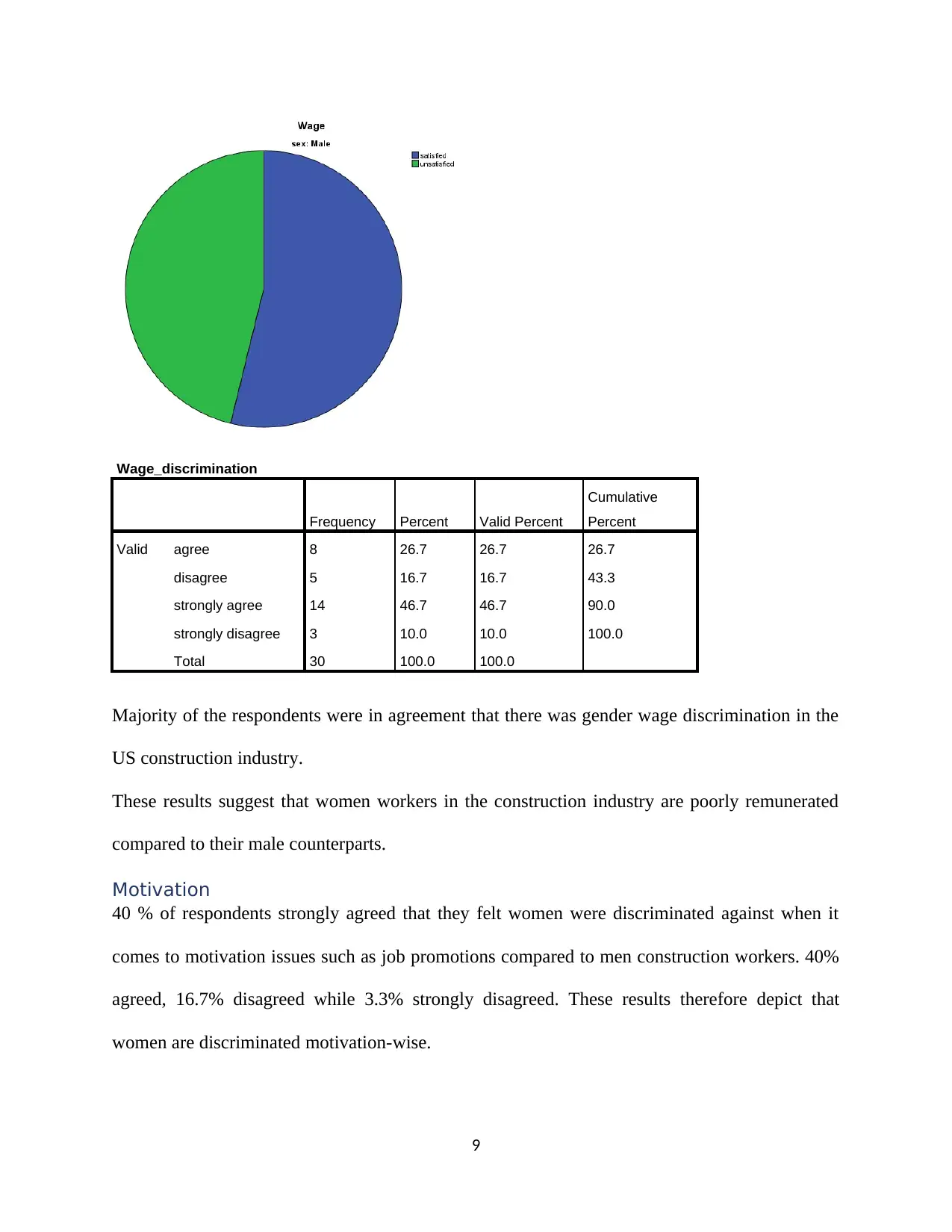
Wage_discrimination
Frequency Percent Valid Percent
Cumulative
Percent
Valid agree 8 26.7 26.7 26.7
disagree 5 16.7 16.7 43.3
strongly agree 14 46.7 46.7 90.0
strongly disagree 3 10.0 10.0 100.0
Total 30 100.0 100.0
Majority of the respondents were in agreement that there was gender wage discrimination in the
US construction industry.
These results suggest that women workers in the construction industry are poorly remunerated
compared to their male counterparts.
Motivation
40 % of respondents strongly agreed that they felt women were discriminated against when it
comes to motivation issues such as job promotions compared to men construction workers. 40%
agreed, 16.7% disagreed while 3.3% strongly disagreed. These results therefore depict that
women are discriminated motivation-wise.
9
Frequency Percent Valid Percent
Cumulative
Percent
Valid agree 8 26.7 26.7 26.7
disagree 5 16.7 16.7 43.3
strongly agree 14 46.7 46.7 90.0
strongly disagree 3 10.0 10.0 100.0
Total 30 100.0 100.0
Majority of the respondents were in agreement that there was gender wage discrimination in the
US construction industry.
These results suggest that women workers in the construction industry are poorly remunerated
compared to their male counterparts.
Motivation
40 % of respondents strongly agreed that they felt women were discriminated against when it
comes to motivation issues such as job promotions compared to men construction workers. 40%
agreed, 16.7% disagreed while 3.3% strongly disagreed. These results therefore depict that
women are discriminated motivation-wise.
9
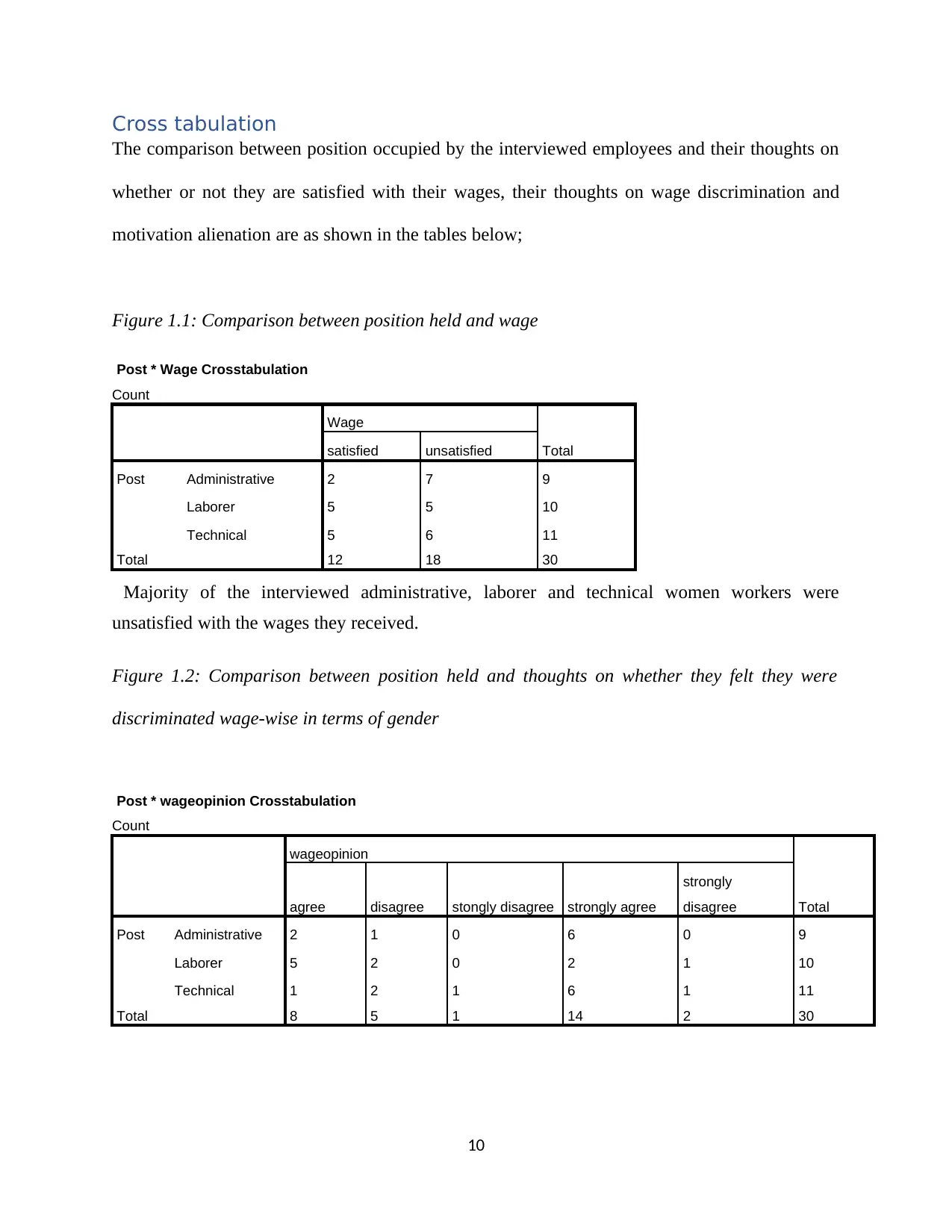
Cross tabulation
The comparison between position occupied by the interviewed employees and their thoughts on
whether or not they are satisfied with their wages, their thoughts on wage discrimination and
motivation alienation are as shown in the tables below;
Figure 1.1: Comparison between position held and wage
Post * Wage Crosstabulation
Count
Wage
Totalsatisfied unsatisfied
Post Administrative 2 7 9
Laborer 5 5 10
Technical 5 6 11
Total 12 18 30
Majority of the interviewed administrative, laborer and technical women workers were
unsatisfied with the wages they received.
Figure 1.2: Comparison between position held and thoughts on whether they felt they were
discriminated wage-wise in terms of gender
Post * wageopinion Crosstabulation
Count
wageopinion
Totalagree disagree stongly disagree strongly agree
strongly
disagree
Post Administrative 2 1 0 6 0 9
Laborer 5 2 0 2 1 10
Technical 1 2 1 6 1 11
Total 8 5 1 14 2 30
10
The comparison between position occupied by the interviewed employees and their thoughts on
whether or not they are satisfied with their wages, their thoughts on wage discrimination and
motivation alienation are as shown in the tables below;
Figure 1.1: Comparison between position held and wage
Post * Wage Crosstabulation
Count
Wage
Totalsatisfied unsatisfied
Post Administrative 2 7 9
Laborer 5 5 10
Technical 5 6 11
Total 12 18 30
Majority of the interviewed administrative, laborer and technical women workers were
unsatisfied with the wages they received.
Figure 1.2: Comparison between position held and thoughts on whether they felt they were
discriminated wage-wise in terms of gender
Post * wageopinion Crosstabulation
Count
wageopinion
Totalagree disagree stongly disagree strongly agree
strongly
disagree
Post Administrative 2 1 0 6 0 9
Laborer 5 2 0 2 1 10
Technical 1 2 1 6 1 11
Total 8 5 1 14 2 30
10
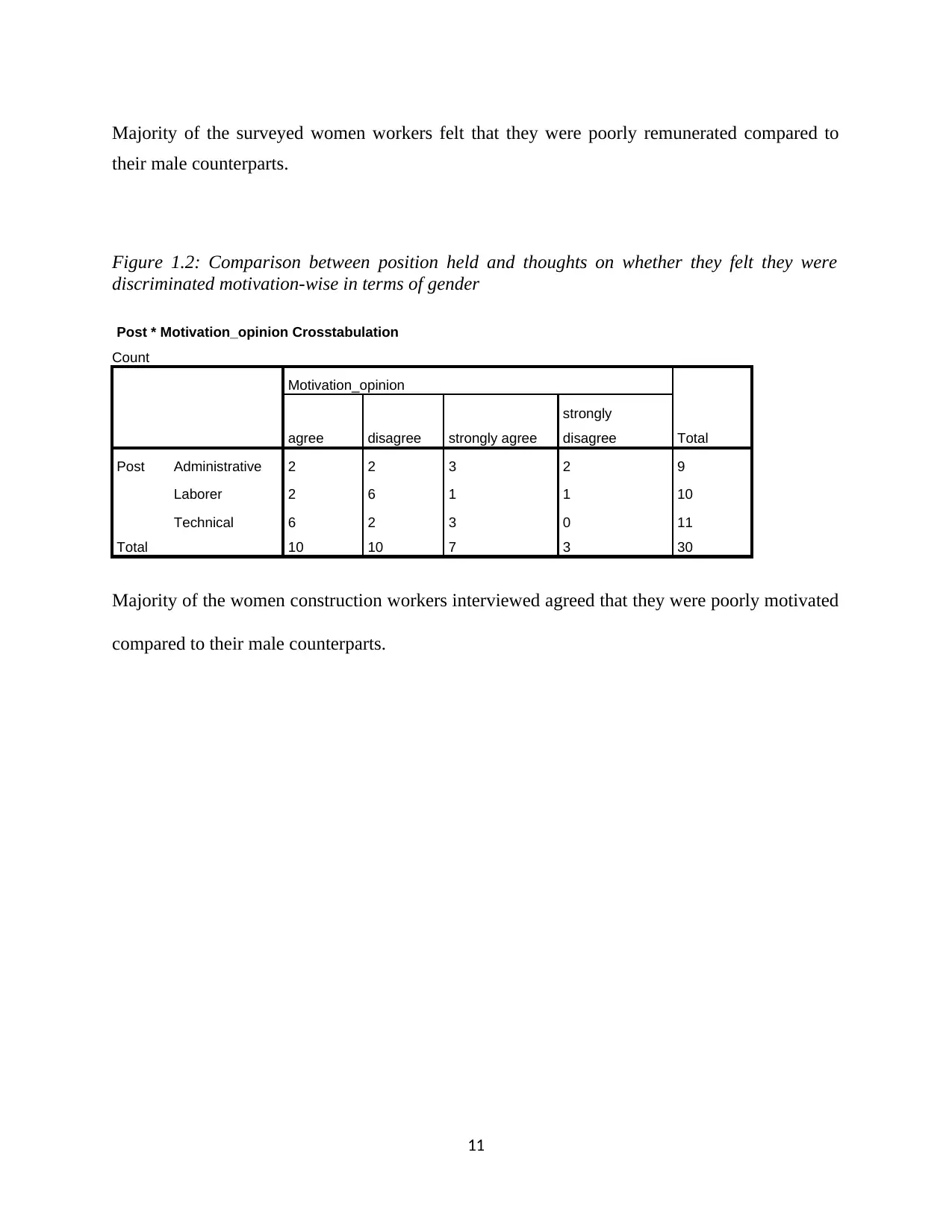
Majority of the surveyed women workers felt that they were poorly remunerated compared to
their male counterparts.
Figure 1.2: Comparison between position held and thoughts on whether they felt they were
discriminated motivation-wise in terms of gender
Post * Motivation_opinion Crosstabulation
Count
Motivation_opinion
Totalagree disagree strongly agree
strongly
disagree
Post Administrative 2 2 3 2 9
Laborer 2 6 1 1 10
Technical 6 2 3 0 11
Total 10 10 7 3 30
Majority of the women construction workers interviewed agreed that they were poorly motivated
compared to their male counterparts.
11
their male counterparts.
Figure 1.2: Comparison between position held and thoughts on whether they felt they were
discriminated motivation-wise in terms of gender
Post * Motivation_opinion Crosstabulation
Count
Motivation_opinion
Totalagree disagree strongly agree
strongly
disagree
Post Administrative 2 2 3 2 9
Laborer 2 6 1 1 10
Technical 6 2 3 0 11
Total 10 10 7 3 30
Majority of the women construction workers interviewed agreed that they were poorly motivated
compared to their male counterparts.
11
Paraphrase This Document
Need a fresh take? Get an instant paraphrase of this document with our AI Paraphraser
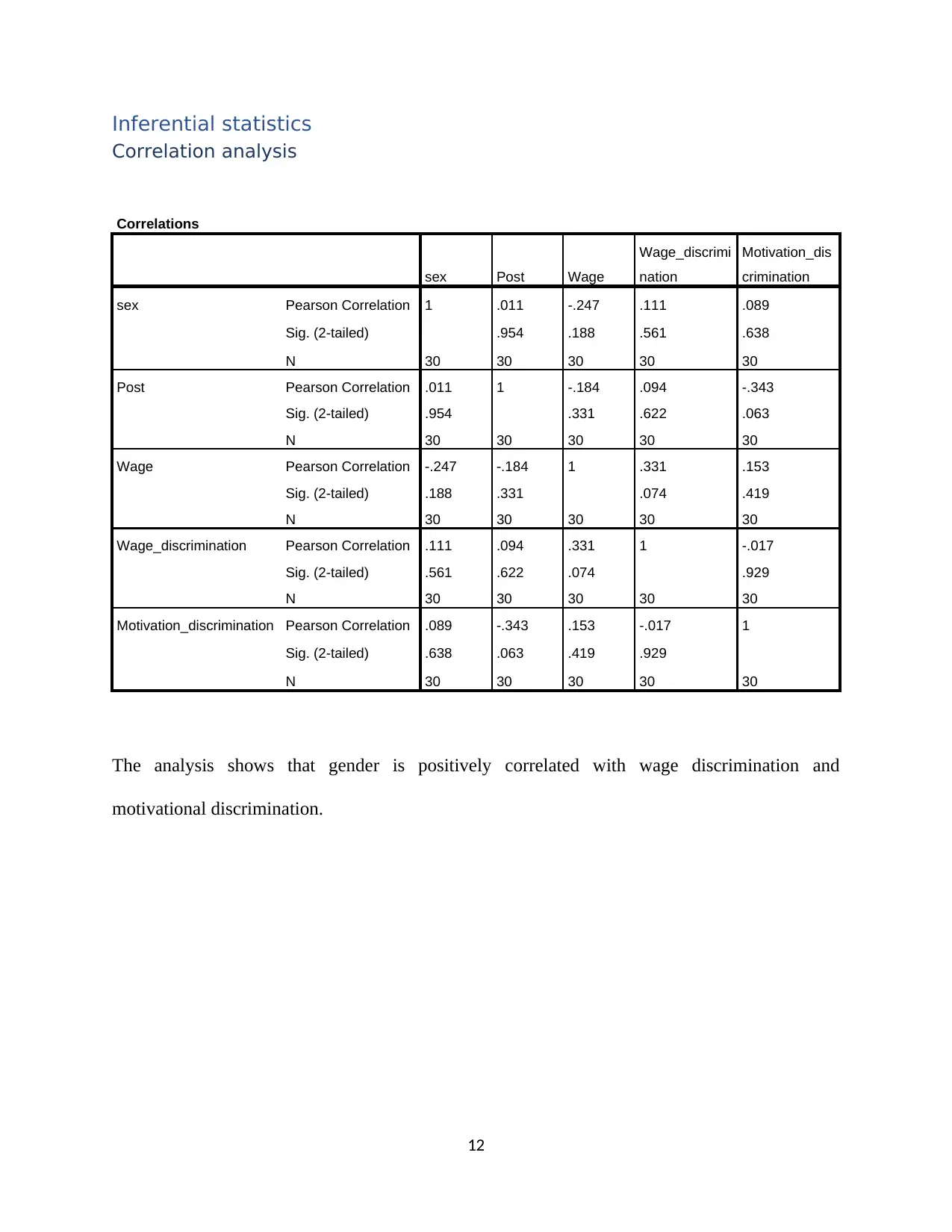
Inferential statistics
Correlation analysis
Correlations
sex Post Wage
Wage_discrimi
nation
Motivation_dis
crimination
sex Pearson Correlation 1 .011 -.247 .111 .089
Sig. (2-tailed) .954 .188 .561 .638
N 30 30 30 30 30
Post Pearson Correlation .011 1 -.184 .094 -.343
Sig. (2-tailed) .954 .331 .622 .063
N 30 30 30 30 30
Wage Pearson Correlation -.247 -.184 1 .331 .153
Sig. (2-tailed) .188 .331 .074 .419
N 30 30 30 30 30
Wage_discrimination Pearson Correlation .111 .094 .331 1 -.017
Sig. (2-tailed) .561 .622 .074 .929
N 30 30 30 30 30
Motivation_discrimination Pearson Correlation .089 -.343 .153 -.017 1
Sig. (2-tailed) .638 .063 .419 .929
N 30 30 30 30 30
The analysis shows that gender is positively correlated with wage discrimination and
motivational discrimination.
12
Correlation analysis
Correlations
sex Post Wage
Wage_discrimi
nation
Motivation_dis
crimination
sex Pearson Correlation 1 .011 -.247 .111 .089
Sig. (2-tailed) .954 .188 .561 .638
N 30 30 30 30 30
Post Pearson Correlation .011 1 -.184 .094 -.343
Sig. (2-tailed) .954 .331 .622 .063
N 30 30 30 30 30
Wage Pearson Correlation -.247 -.184 1 .331 .153
Sig. (2-tailed) .188 .331 .074 .419
N 30 30 30 30 30
Wage_discrimination Pearson Correlation .111 .094 .331 1 -.017
Sig. (2-tailed) .561 .622 .074 .929
N 30 30 30 30 30
Motivation_discrimination Pearson Correlation .089 -.343 .153 -.017 1
Sig. (2-tailed) .638 .063 .419 .929
N 30 30 30 30 30
The analysis shows that gender is positively correlated with wage discrimination and
motivational discrimination.
12
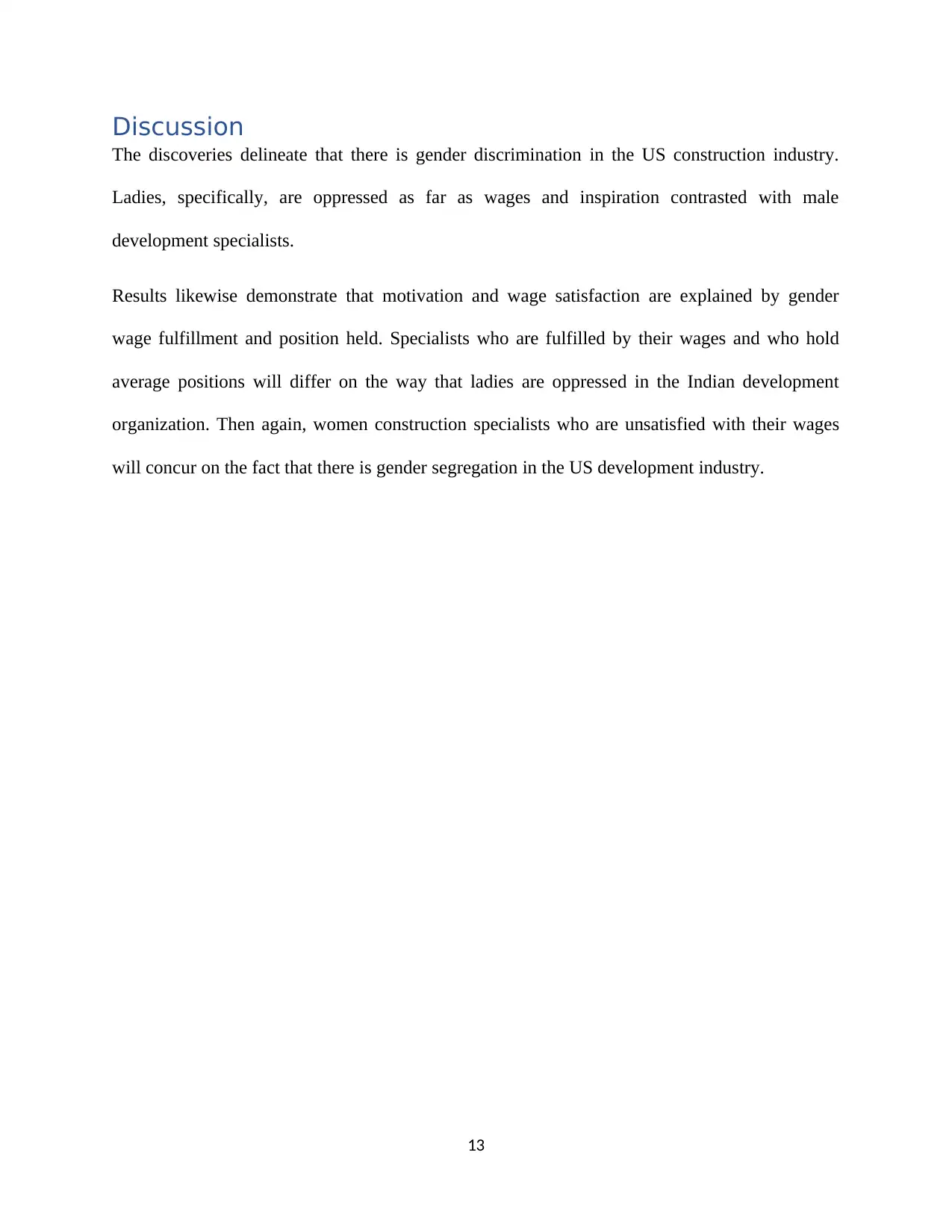
Discussion
The discoveries delineate that there is gender discrimination in the US construction industry.
Ladies, specifically, are oppressed as far as wages and inspiration contrasted with male
development specialists.
Results likewise demonstrate that motivation and wage satisfaction are explained by gender
wage fulfillment and position held. Specialists who are fulfilled by their wages and who hold
average positions will differ on the way that ladies are oppressed in the Indian development
organization. Then again, women construction specialists who are unsatisfied with their wages
will concur on the fact that there is gender segregation in the US development industry.
13
The discoveries delineate that there is gender discrimination in the US construction industry.
Ladies, specifically, are oppressed as far as wages and inspiration contrasted with male
development specialists.
Results likewise demonstrate that motivation and wage satisfaction are explained by gender
wage fulfillment and position held. Specialists who are fulfilled by their wages and who hold
average positions will differ on the way that ladies are oppressed in the Indian development
organization. Then again, women construction specialists who are unsatisfied with their wages
will concur on the fact that there is gender segregation in the US development industry.
13
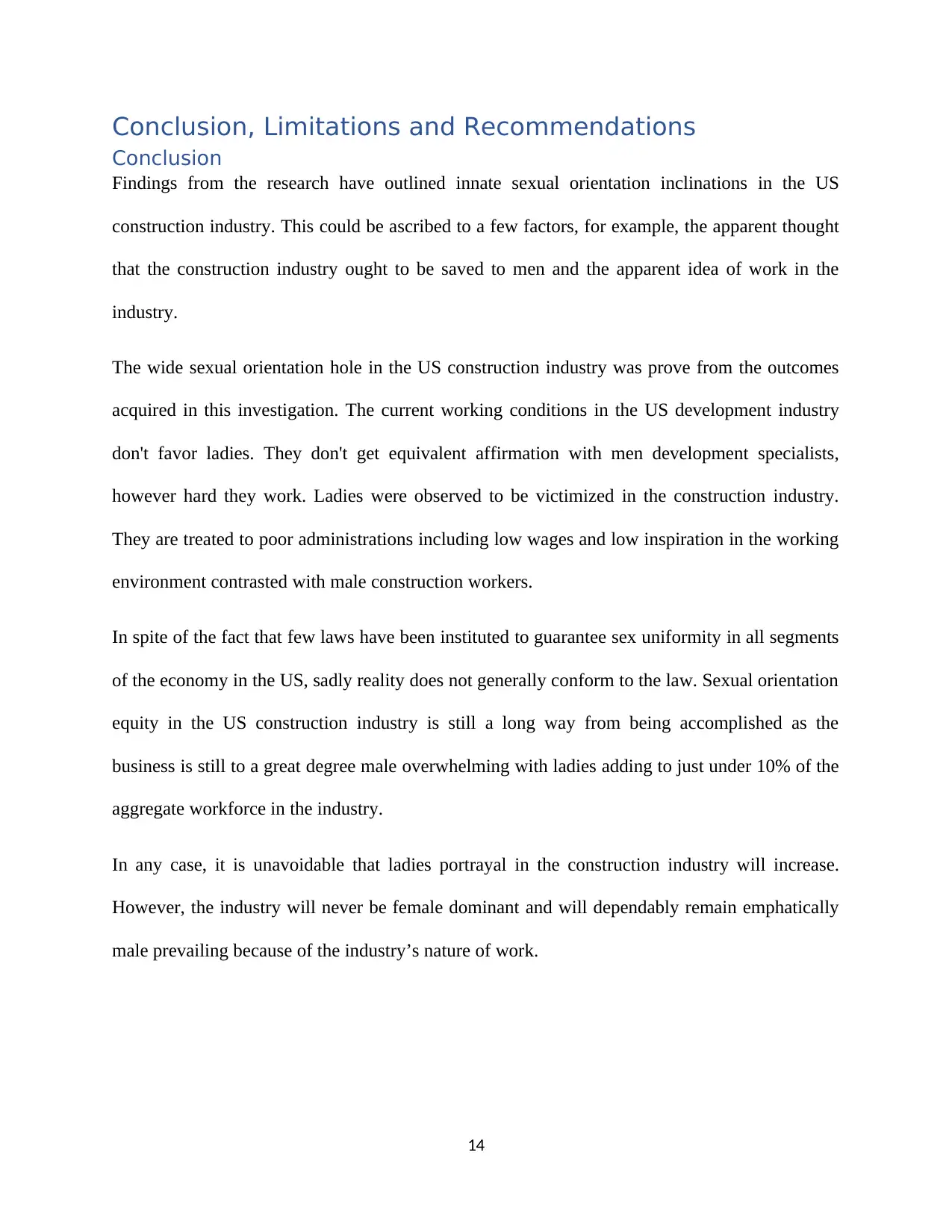
Conclusion, Limitations and Recommendations
Conclusion
Findings from the research have outlined innate sexual orientation inclinations in the US
construction industry. This could be ascribed to a few factors, for example, the apparent thought
that the construction industry ought to be saved to men and the apparent idea of work in the
industry.
The wide sexual orientation hole in the US construction industry was prove from the outcomes
acquired in this investigation. The current working conditions in the US development industry
don't favor ladies. They don't get equivalent affirmation with men development specialists,
however hard they work. Ladies were observed to be victimized in the construction industry.
They are treated to poor administrations including low wages and low inspiration in the working
environment contrasted with male construction workers.
In spite of the fact that few laws have been instituted to guarantee sex uniformity in all segments
of the economy in the US, sadly reality does not generally conform to the law. Sexual orientation
equity in the US construction industry is still a long way from being accomplished as the
business is still to a great degree male overwhelming with ladies adding to just under 10% of the
aggregate workforce in the industry.
In any case, it is unavoidable that ladies portrayal in the construction industry will increase.
However, the industry will never be female dominant and will dependably remain emphatically
male prevailing because of the industry’s nature of work.
14
Conclusion
Findings from the research have outlined innate sexual orientation inclinations in the US
construction industry. This could be ascribed to a few factors, for example, the apparent thought
that the construction industry ought to be saved to men and the apparent idea of work in the
industry.
The wide sexual orientation hole in the US construction industry was prove from the outcomes
acquired in this investigation. The current working conditions in the US development industry
don't favor ladies. They don't get equivalent affirmation with men development specialists,
however hard they work. Ladies were observed to be victimized in the construction industry.
They are treated to poor administrations including low wages and low inspiration in the working
environment contrasted with male construction workers.
In spite of the fact that few laws have been instituted to guarantee sex uniformity in all segments
of the economy in the US, sadly reality does not generally conform to the law. Sexual orientation
equity in the US construction industry is still a long way from being accomplished as the
business is still to a great degree male overwhelming with ladies adding to just under 10% of the
aggregate workforce in the industry.
In any case, it is unavoidable that ladies portrayal in the construction industry will increase.
However, the industry will never be female dominant and will dependably remain emphatically
male prevailing because of the industry’s nature of work.
14
Secure Best Marks with AI Grader
Need help grading? Try our AI Grader for instant feedback on your assignments.
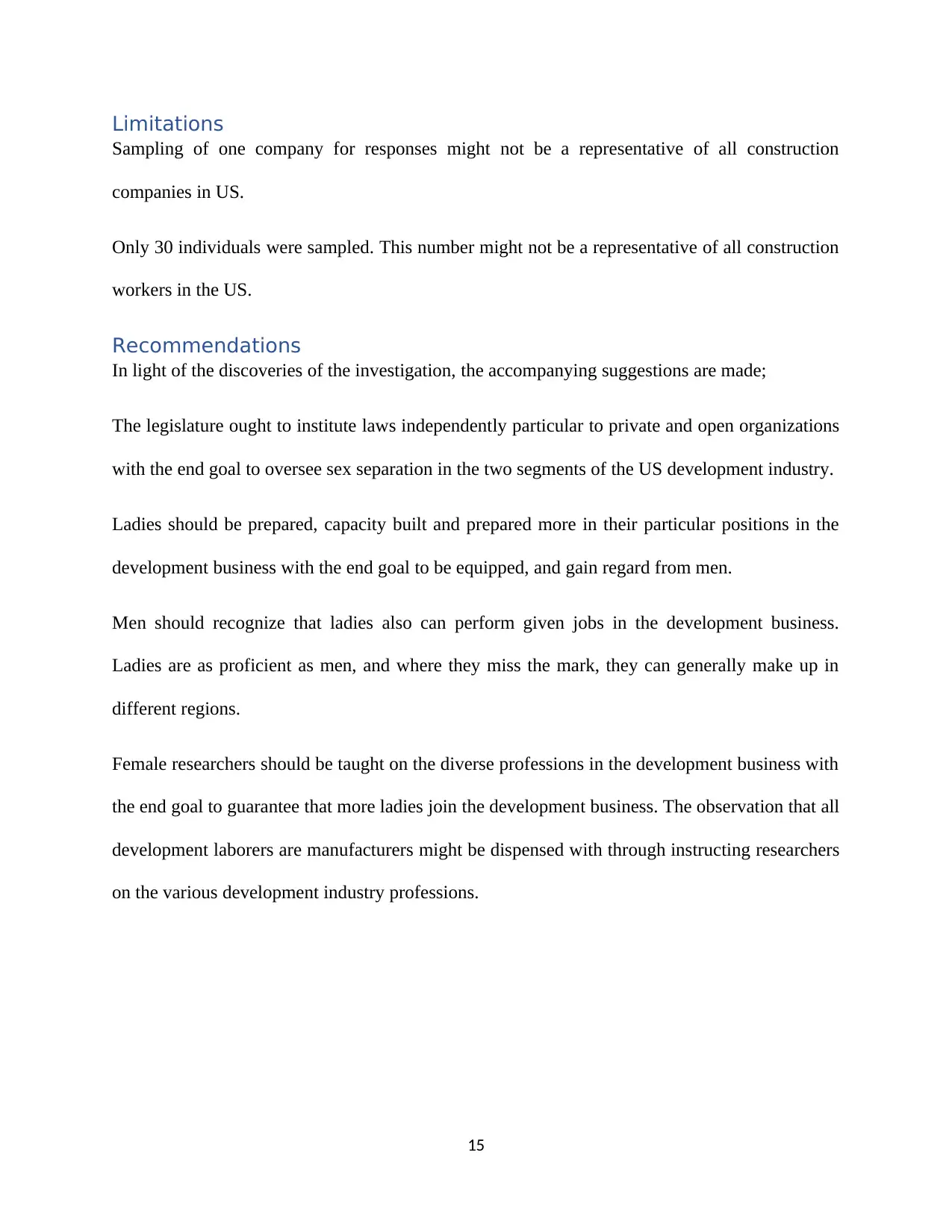
Limitations
Sampling of one company for responses might not be a representative of all construction
companies in US.
Only 30 individuals were sampled. This number might not be a representative of all construction
workers in the US.
Recommendations
In light of the discoveries of the investigation, the accompanying suggestions are made;
The legislature ought to institute laws independently particular to private and open organizations
with the end goal to oversee sex separation in the two segments of the US development industry.
Ladies should be prepared, capacity built and prepared more in their particular positions in the
development business with the end goal to be equipped, and gain regard from men.
Men should recognize that ladies also can perform given jobs in the development business.
Ladies are as proficient as men, and where they miss the mark, they can generally make up in
different regions.
Female researchers should be taught on the diverse professions in the development business with
the end goal to guarantee that more ladies join the development business. The observation that all
development laborers are manufacturers might be dispensed with through instructing researchers
on the various development industry professions.
15
Sampling of one company for responses might not be a representative of all construction
companies in US.
Only 30 individuals were sampled. This number might not be a representative of all construction
workers in the US.
Recommendations
In light of the discoveries of the investigation, the accompanying suggestions are made;
The legislature ought to institute laws independently particular to private and open organizations
with the end goal to oversee sex separation in the two segments of the US development industry.
Ladies should be prepared, capacity built and prepared more in their particular positions in the
development business with the end goal to be equipped, and gain regard from men.
Men should recognize that ladies also can perform given jobs in the development business.
Ladies are as proficient as men, and where they miss the mark, they can generally make up in
different regions.
Female researchers should be taught on the diverse professions in the development business with
the end goal to guarantee that more ladies join the development business. The observation that all
development laborers are manufacturers might be dispensed with through instructing researchers
on the various development industry professions.
15
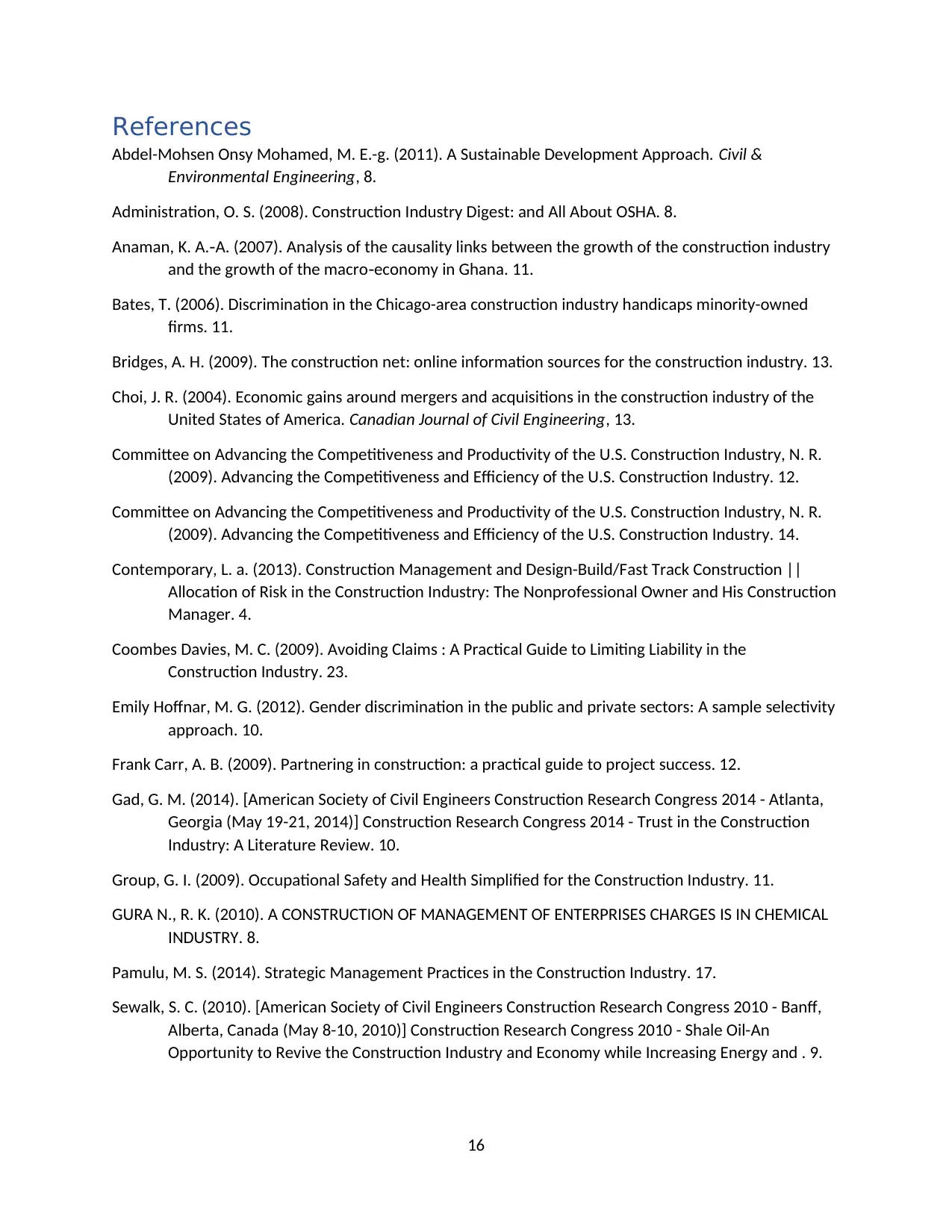
References
Abdel-Mohsen Onsy Mohamed, M. E.-g. (2011). A Sustainable Development Approach. Civil &
Environmental Engineering, 8.
Administration, O. S. (2008). Construction Industry Digest: and All About OSHA. 8.
Anaman, K. A. A. (2007). Analysis of the causality links between the growth of the construction industry‐
and the growth of the macro economy in Ghana. 11.‐
Bates, T. (2006). Discrimination in the Chicago-area construction industry handicaps minority-owned
firms. 11.
Bridges, A. H. (2009). The construction net: online information sources for the construction industry. 13.
Choi, J. R. (2004). Economic gains around mergers and acquisitions in the construction industry of the
United States of America. Canadian Journal of Civil Engineering, 13.
Committee on Advancing the Competitiveness and Productivity of the U.S. Construction Industry, N. R.
(2009). Advancing the Competitiveness and Efficiency of the U.S. Construction Industry. 12.
Committee on Advancing the Competitiveness and Productivity of the U.S. Construction Industry, N. R.
(2009). Advancing the Competitiveness and Efficiency of the U.S. Construction Industry. 14.
Contemporary, L. a. (2013). Construction Management and Design-Build/Fast Track Construction ||
Allocation of Risk in the Construction Industry: The Nonprofessional Owner and His Construction
Manager. 4.
Coombes Davies, M. C. (2009). Avoiding Claims : A Practical Guide to Limiting Liability in the
Construction Industry. 23.
Emily Hoffnar, M. G. (2012). Gender discrimination in the public and private sectors: A sample selectivity
approach. 10.
Frank Carr, A. B. (2009). Partnering in construction: a practical guide to project success. 12.
Gad, G. M. (2014). [American Society of Civil Engineers Construction Research Congress 2014 - Atlanta,
Georgia (May 19-21, 2014)] Construction Research Congress 2014 - Trust in the Construction
Industry: A Literature Review. 10.
Group, G. I. (2009). Occupational Safety and Health Simplified for the Construction Industry. 11.
GURA N., R. K. (2010). А CONSTRUCTION OF MANAGEMENT OF ENTERPRISES CHARGES IS IN CHEMICAL
INDUSTRY. 8.
Pamulu, M. S. (2014). Strategic Management Practices in the Construction Industry. 17.
Sewalk, S. C. (2010). [American Society of Civil Engineers Construction Research Congress 2010 - Banff,
Alberta, Canada (May 8-10, 2010)] Construction Research Congress 2010 - Shale Oil-An
Opportunity to Revive the Construction Industry and Economy while Increasing Energy and . 9.
16
Abdel-Mohsen Onsy Mohamed, M. E.-g. (2011). A Sustainable Development Approach. Civil &
Environmental Engineering, 8.
Administration, O. S. (2008). Construction Industry Digest: and All About OSHA. 8.
Anaman, K. A. A. (2007). Analysis of the causality links between the growth of the construction industry‐
and the growth of the macro economy in Ghana. 11.‐
Bates, T. (2006). Discrimination in the Chicago-area construction industry handicaps minority-owned
firms. 11.
Bridges, A. H. (2009). The construction net: online information sources for the construction industry. 13.
Choi, J. R. (2004). Economic gains around mergers and acquisitions in the construction industry of the
United States of America. Canadian Journal of Civil Engineering, 13.
Committee on Advancing the Competitiveness and Productivity of the U.S. Construction Industry, N. R.
(2009). Advancing the Competitiveness and Efficiency of the U.S. Construction Industry. 12.
Committee on Advancing the Competitiveness and Productivity of the U.S. Construction Industry, N. R.
(2009). Advancing the Competitiveness and Efficiency of the U.S. Construction Industry. 14.
Contemporary, L. a. (2013). Construction Management and Design-Build/Fast Track Construction ||
Allocation of Risk in the Construction Industry: The Nonprofessional Owner and His Construction
Manager. 4.
Coombes Davies, M. C. (2009). Avoiding Claims : A Practical Guide to Limiting Liability in the
Construction Industry. 23.
Emily Hoffnar, M. G. (2012). Gender discrimination in the public and private sectors: A sample selectivity
approach. 10.
Frank Carr, A. B. (2009). Partnering in construction: a practical guide to project success. 12.
Gad, G. M. (2014). [American Society of Civil Engineers Construction Research Congress 2014 - Atlanta,
Georgia (May 19-21, 2014)] Construction Research Congress 2014 - Trust in the Construction
Industry: A Literature Review. 10.
Group, G. I. (2009). Occupational Safety and Health Simplified for the Construction Industry. 11.
GURA N., R. K. (2010). А CONSTRUCTION OF MANAGEMENT OF ENTERPRISES CHARGES IS IN CHEMICAL
INDUSTRY. 8.
Pamulu, M. S. (2014). Strategic Management Practices in the Construction Industry. 17.
Sewalk, S. C. (2010). [American Society of Civil Engineers Construction Research Congress 2010 - Banff,
Alberta, Canada (May 8-10, 2010)] Construction Research Congress 2010 - Shale Oil-An
Opportunity to Revive the Construction Industry and Economy while Increasing Energy and . 9.
16

White, J. S. (2010). Constructing Gender: Discrimination and the Law in the US. Agenda: Empowering
Women for Gender Equity, 11.
Xu, H. W. (2014). [Intelligent Systems, Control and Automation: Science and Engineering] Optimization
and Control Methods in Industrial Engineering and Construction Volume 72 || Lean and Agile
Construction Project Management: As a Way of Reducing Environmental Footprint of. 18.
17
Women for Gender Equity, 11.
Xu, H. W. (2014). [Intelligent Systems, Control and Automation: Science and Engineering] Optimization
and Control Methods in Industrial Engineering and Construction Volume 72 || Lean and Agile
Construction Project Management: As a Way of Reducing Environmental Footprint of. 18.
17
Paraphrase This Document
Need a fresh take? Get an instant paraphrase of this document with our AI Paraphraser
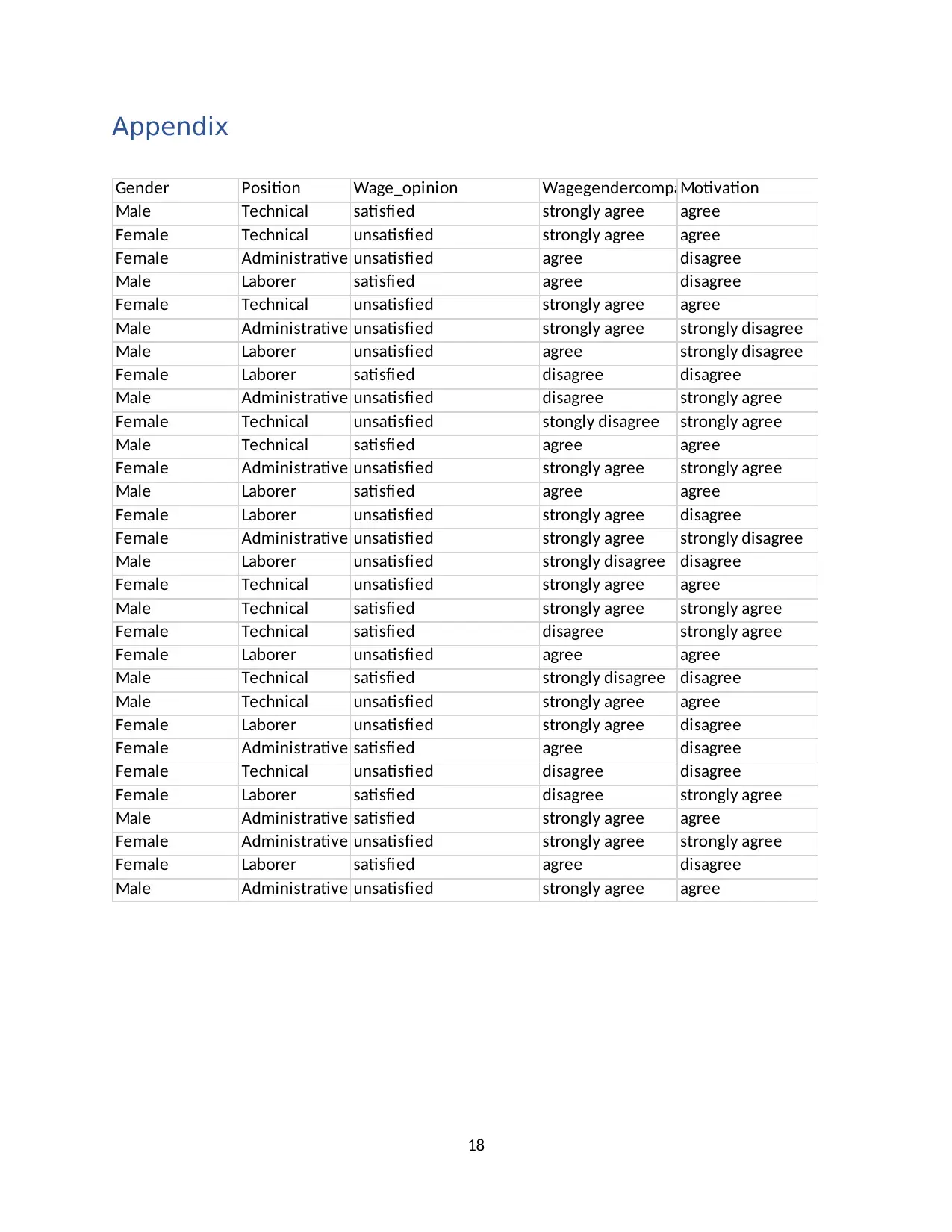
Appendix
Gender Position Wage_opinion WagegendercomparisonMotivation
Male Technical satisfied strongly agree agree
Female Technical unsatisfied strongly agree agree
Female Administrative unsatisfied agree disagree
Male Laborer satisfied agree disagree
Female Technical unsatisfied strongly agree agree
Male Administrative unsatisfied strongly agree strongly disagree
Male Laborer unsatisfied agree strongly disagree
Female Laborer satisfied disagree disagree
Male Administrative unsatisfied disagree strongly agree
Female Technical unsatisfied stongly disagree strongly agree
Male Technical satisfied agree agree
Female Administrative unsatisfied strongly agree strongly agree
Male Laborer satisfied agree agree
Female Laborer unsatisfied strongly agree disagree
Female Administrative unsatisfied strongly agree strongly disagree
Male Laborer unsatisfied strongly disagree disagree
Female Technical unsatisfied strongly agree agree
Male Technical satisfied strongly agree strongly agree
Female Technical satisfied disagree strongly agree
Female Laborer unsatisfied agree agree
Male Technical satisfied strongly disagree disagree
Male Technical unsatisfied strongly agree agree
Female Laborer unsatisfied strongly agree disagree
Female Administrative satisfied agree disagree
Female Technical unsatisfied disagree disagree
Female Laborer satisfied disagree strongly agree
Male Administrative satisfied strongly agree agree
Female Administrative unsatisfied strongly agree strongly agree
Female Laborer satisfied agree disagree
Male Administrative unsatisfied strongly agree agree
18
Gender Position Wage_opinion WagegendercomparisonMotivation
Male Technical satisfied strongly agree agree
Female Technical unsatisfied strongly agree agree
Female Administrative unsatisfied agree disagree
Male Laborer satisfied agree disagree
Female Technical unsatisfied strongly agree agree
Male Administrative unsatisfied strongly agree strongly disagree
Male Laborer unsatisfied agree strongly disagree
Female Laborer satisfied disagree disagree
Male Administrative unsatisfied disagree strongly agree
Female Technical unsatisfied stongly disagree strongly agree
Male Technical satisfied agree agree
Female Administrative unsatisfied strongly agree strongly agree
Male Laborer satisfied agree agree
Female Laborer unsatisfied strongly agree disagree
Female Administrative unsatisfied strongly agree strongly disagree
Male Laborer unsatisfied strongly disagree disagree
Female Technical unsatisfied strongly agree agree
Male Technical satisfied strongly agree strongly agree
Female Technical satisfied disagree strongly agree
Female Laborer unsatisfied agree agree
Male Technical satisfied strongly disagree disagree
Male Technical unsatisfied strongly agree agree
Female Laborer unsatisfied strongly agree disagree
Female Administrative satisfied agree disagree
Female Technical unsatisfied disagree disagree
Female Laborer satisfied disagree strongly agree
Male Administrative satisfied strongly agree agree
Female Administrative unsatisfied strongly agree strongly agree
Female Laborer satisfied agree disagree
Male Administrative unsatisfied strongly agree agree
18

19
1 out of 21
Related Documents
Your All-in-One AI-Powered Toolkit for Academic Success.
+13062052269
info@desklib.com
Available 24*7 on WhatsApp / Email
![[object Object]](/_next/static/media/star-bottom.7253800d.svg)
Unlock your academic potential
© 2024 | Zucol Services PVT LTD | All rights reserved.




